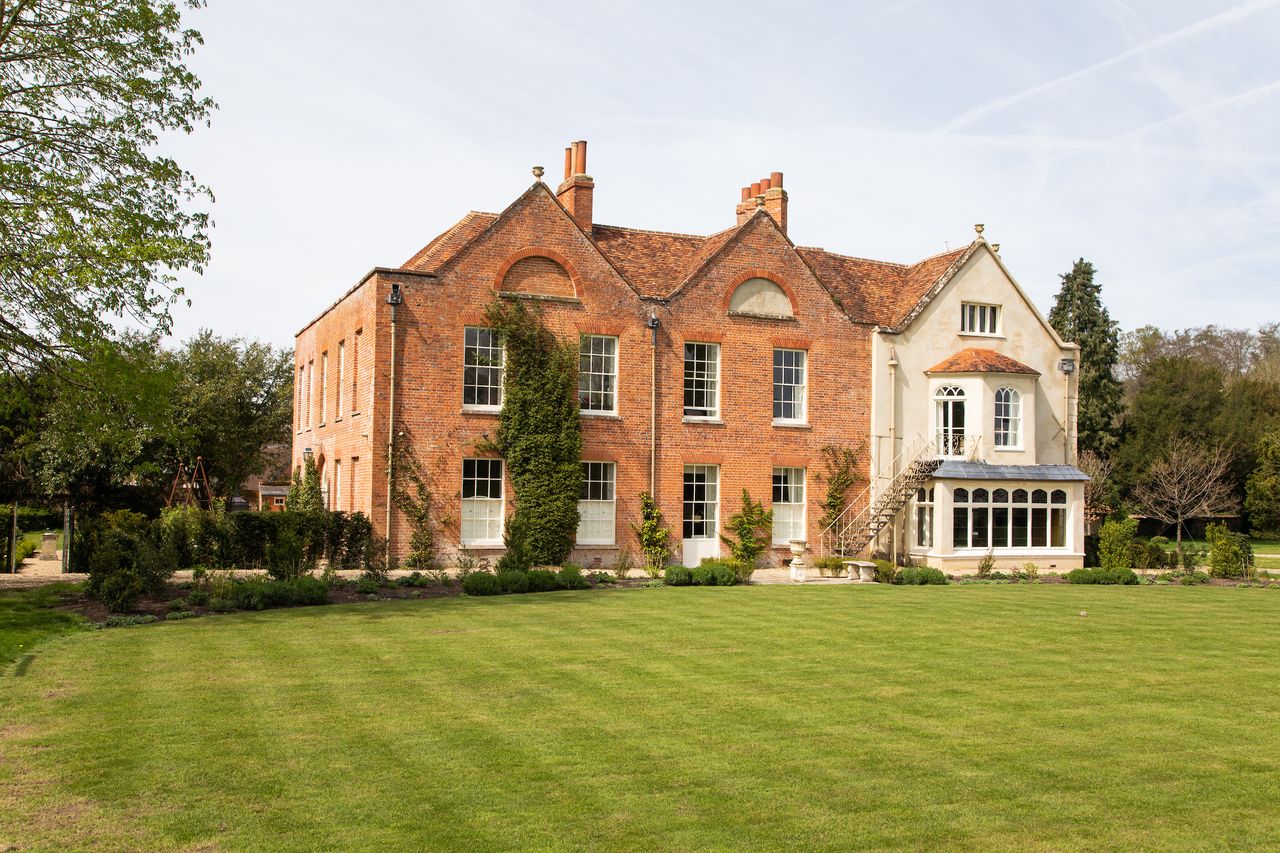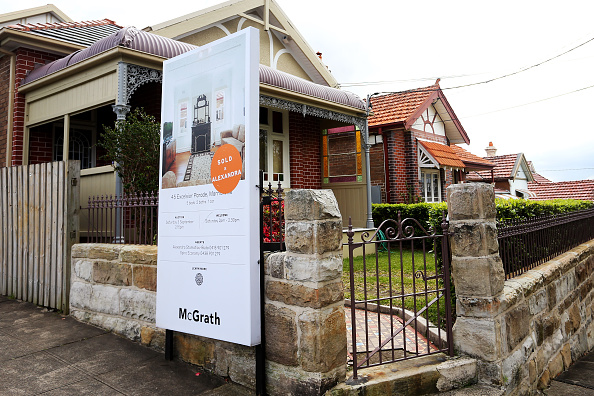Bats, Asbestos, a Leaky Roof: This English Estate Proved to be the Ultimate Fixer-Upper
Nobody wanted to buy Harpsden Court. But Ian and Gigi Wason took the ‘complete disaster zone’ head on, working little by little to turn it into a liveable home.
Growing up, Ian Wason often wondered what lay behind the tall stone walls surrounding Harpsden Court, a 400-year-old country estate close to his childhood home. It was many years before he discovered the answer: a beguiling but badly rundown, 17,000-square-foot landmark property in need of a multimillion-dollar restoration.
Despite the overwhelming scale of the project, he and his wife, Gigi Wason, fell for the charms of Harpsden Court, took on the project, and have reinvented it as a classic country home for their young family.
“It was basically semi-derelict when we first saw it,” said Ian. “Parts of it literally hadn’t been touched for almost 100 years and it had been on the market for four years. It was this complete disaster zone, which is why nobody bought it. We were the first and only people to put in an offer.”
Ian, 46, was raised 5 miles away from Harpsden Court, in the village of Medmenham, some 35 miles west of central London. After training as an accountant in London, he moved to Cape Town, South Africa, where he set up a debt counseling and financial-education company, and met Gigi, a 42-year-old interior designer.
In 2015, on a visit home to Ian’s parents, who were still living in Medmenham, he noticed that Harpsden Court was up for sale, listed for $16.43 million. He persuaded Gigi to go and have a look just to ease his curiosity.
What they discovered terrified them.
“It was overwhelming,” said Gigi. “It was obviously going to be such a mammoth project. You could see the sky through the roof, there was a whole zoo in the house—bats, crows, rats and mice—and it was dark and freezing cold.”
In 2017, Ian, Gigi and their daughters, Clementine, now 11, and Josephine, 9, returned to the U.K. They bought a house in London’s Notting Hill neighborhood, and welcomed another child, Madeline, now 5. But, over the next couple of years, Gigi started to hanker for more space than a London townhouse could offer. When Ian, who had always hoped to live in the country close to his family, mentioned the house was still for sale, and that its list price had been slashed to $11.42 million, Gigi agreed to another visit. This time around she was ready to appreciate the Gothic-style house.
Harpsden Court dates from the 17th century, according to Historic England, Britain’s official heritage organization. New sections were added to the house in the 18th and 19th centuries. According to the Henley Archaeological and Historical Group, the house was originally home to Lords of the Manor of Harpsden and, according to an ancient map of the area, there has been a house was on the site as far back as 1586.
It had been used as a location for a series of movies including “Quantum of Solace,” starring Daniel Craig, “The Woman in Black” with Daniel Radcliffe, and “Jude” starring Christopher Eccleston and Kate Winslet.
Outside, its 30 acres of gardens, woodland and fields easily outshone the tiny Astroturfed backyard of the Wasons’ London house. “It was like I saw the house with completely different eyes,” she said. “It was magical, and I was obsessed.”
In 2019, the couple paid $7.29 million for Harpsden Court, which came with three cottages and stables. The main house was habitable but not comfortable. Most of it had no central heating, the roof leaked, and Gigi describes the kitchen, fitted in the 1960s, as “unspeakably awful.” The property had 14 bedrooms, but only two bathrooms.
The Wasons hired the architect Ben Pentreath, who has worked for high-profile clients including King Charles and the Prince and Princess of Wales, and asked him for a light-touch modernisation plan.
“We did not want to lose the character of the house,” said Gigi. “I like designs which are timeless and I think that if you create something modern at some point it will tire.”
Pentreath suggested replacing the 1960s kitchen and adjacent open courtyard with a new, enlarged kitchen. The servant’s wing of the house, built in the Victorian era, was cramped and gloomy. “It was just a long corridor with loads of rooms off it, like the hotel in ‘The Shining,’ ” said Ian.
Pentreath recommended removing part of the first floor ceiling to create a galleried, double-height hallway with walls of painted brick and the original stone floors. To make the house more balanced, the number of bedrooms has been reduced to 10, and the number of bathrooms upped to six. Outside, the gardens needed re-landscaping, and the Wasons wanted a sauna and a swimming pool.
Work on the house began later in 2019. Alterations to landmark buildings in Britain require special building permits, which can take several months to obtain from local government planning departments, but they were permitted to get on with basic repairs such as the removal of carcinogenic asbestos insulation, installing a new roof, and restoration of the windows.
Removing asbestos from the roof was particularly difficult. “It was a very painful process,” said Ian. Before removal work could even begin, he had to commission an $14,000 report to determine whether there were any protected species of bats nesting in the roof space. These bats had to be carefully removed before a section of the roof was removed. “The asbestos removers then put on their hazmat suits and spent six weeks carefully removing the asbestos lagging from the heating pipes in the roof,” said Ian. This part of the work ate up $190,000, said Ian.
The backyard presented another challenge. It had been infested with highly invasive Japanese knotweed. The previous owners had tried to tackle the problem, said Ian, and had purchased a roughly $6,300, 10-year insurance policy to tackle any recurrence. Since the plant’s root network is notoriously hard to eradicate, contractors have to visit the property twice a year to spray and remove any new plants.
Back in the house, all the windows had to be removed, renovated, and reinstalled, adding another roughly $127,000 to the final bill. “We saved most of them, and where we couldn’t they were completely replaced with new oak windows,” said Ian.
Ian, who managed the construction himself, also oversaw the dredging of the ornamental lake in the grounds, and the installation of a ground source heat pump and central heating.
Then the electrics were tackled. “From the plans we had it had last been rewired in 1936,” said Ian.
Ian estimates that around a third of the total $7.6 million renovation budget was spent on these structural upgrades, carried out while the family remained living in London. Building permits were issued in spring 2020 for the alterations Pentreath had designed, and another third of the money was spent here. The final third went on decoration and finishes, overseen by Gigi who has created a comfortable country-house style home, with a soft and neutral color scheme.
Where possible the fabric of the house has been preserved. The flagstone floors, taken up when the new heating system was installed, were carefully re-laid. The decorative tiles around the range cooker in the kitchen were taken out of one of the original bathrooms, and as much of the original wallpaper as possible has been salvaged and restored. This, said Gigi, involved an artist spending six weeks at the house carefully redrawing patterns on water-damaged sections of the walls, and repainting them so that they blend seamlessly with the surviving sections of paper. The cost? Around $15,200, said Ian.
The first floor has a series of living rooms, a formal dining room, and a well-preserved original kitchen complex. Gigi now uses the main room of this complex for flower arranging and children’s arts and crafts, and there is also a hanging larder for preserving game birds, a pastry room, and a wine cellar.
There are three staircases leading to the second floor, the grandest of which is lighted by a stained-glass window depicting St George, the patron saint of England, battling a dragon. undefined One bedroom is dubbed the “Queen Mary” room, named by a previous owner for Queen Mary, who is rumored to have been a guest at the house.
This room has a four-poster bed, pretty tiled fireplace, and an exceptionally lavish en suite bathroom, with a free-standing wooden bathtub and wallpaper featuring oriental-style blossom trees. The principal bedroom is equally splendid with its bespoke hand-painted wallpaper by de Gournay featuring swans and white peacocks, a gilded French-style bed, and soft green silk moiré drapes.
The house contains many surprises; a bookshelf in Ian’s office is a hidden door leading to the original gun room, and if you look closely at the restored wallpaper in an upstairs hallway, a confection of fruit, berries and birds, there is a tiny naked nymph added by a previous resident, plus three miniature fairies Gigi had painted in honor of her daughters.
By Christmas 2021, two years after the reconstruction began, the family, plus dogs Tess and Charlie, were able to move into the Victorian wing, which was completed first. They have kept their London property for when Ian needs to be in London for work and for family trips.
Since then, Ian’s parents have moved into one of the cottages. Gigi’s cousin and her husband live in another.
Ian estimates that although $7.6 million has been spent on the renovation so far, more than the house cost to buy, that sum will keep going up. At the start of the year, for example, a section of the decorative domed ceiling in the music room—a second-floor reception area—collapsed unexpectedly and awaits repair. Work to shore up the stone walls in the garden is ongoing. And Gigi hasn’t got around to designing several of the guest bedrooms to her satisfaction.
“This project is going to go on forever,” she said.
 Copyright 2020, Dow Jones & Company, Inc. All Rights Reserved Worldwide. LEARN MORE
Copyright 2020, Dow Jones & Company, Inc. All Rights Reserved Worldwide. LEARN MORE
This stylish family home combines a classic palette and finishes with a flexible floorplan
Just 55 minutes from Sydney, make this your creative getaway located in the majestic Hawkesbury region.
The announcement follows shareholder and regulatory approvals being met
Knight Frank and Bayleys has completed its acquisition of leading Australian real estate firm, McGrath Limited, it was announced today.
The news follows regulatory and shareholder approval, with the Scheme of Arrangement coming into effect on June 17 and implemented on June 27.
McGrath Limited is the third largest real estate group in the country, according the data from CoreLogic, behind behemoth Ray White and stalwart LJ Hooker.
McGrath founder and CEO John McGrath said in a statement that he welcomed the move.
“We are delighted to be joining forces with two of the greatest real estate brands in the world,” Mr McGrath said. “Knight Frank is the most prestigious residential agency globally and provides us and our customers with instant access to the best global network and the most sophisticated international buyers in the world.
“Our goal is to build Australia’s leading and finest real estate brand over the next few years and this new partnership and network puts us in an extraordinarily strong position to do just that.”

Between them, Knight Frank and McGrath have 171 offices across Australia and Knight Frank is the largest privately owned real estate agency in the world with more than 740 offices worldwide.
Mr McGrath will remain at McGrath Limited as chief executive and managing director and retain his 23.3 percent shareholding in the company. Mr McGrath will also be on the new board of directors, along with Knight Frank Australia CEO James Patterson, Knight Frank Global head of residential Rupert Dawes, Bayleys managing director Mike Bayley and Bayleys finance director Ken MacRae.
Mr Patterson, CEO at Knight Frank Australia, said the acquisition represented a significant milestone in the company’s international expansion.
“McGrath is a great fit culturally,” he said. “We are aligned on many areas including our values, how we operate and our brand positioning. The Knight Frank, Bayleys and McGrath teams will continue to operate on a ” business as usual” basis, but with each party gaining access to vastly broadened networks, stretching across multiple borders, unlocking greater opportunities for our clients.”
This stylish family home combines a classic palette and finishes with a flexible floorplan
Just 55 minutes from Sydney, make this your creative getaway located in the majestic Hawkesbury region.






















